Shoeing Horses at Stanford
In January I decided to finally take some images at the Stanford Equestrian Center in my hometown of Palo Alto. Since childhood, I always knew it was where Eadweard Muybridge and Leland Standford had chosen to settle the great debate. What was that great debate? Stanford wanted to prove an ongoing debate at the time as to whether or not a horse has all four feet off the ground at one time while trotting. Leland believed in the "unsupported transit" theory, but wanted scientific proof. So, in 1872, Stanford hired the British publisher agent/bookseller/photographer and acquitted murderer to prove him right. Muybridge set up a series of cameras along a track (well before the "Matrix" craze), and tripped the cameras via a series of strings. Sure enough, as the hooves regrouped under the horse, Standardbred trotting horse Occident was completely off the ground. As a photographer (and former film student), it was this story that finally brought me to this historical site.
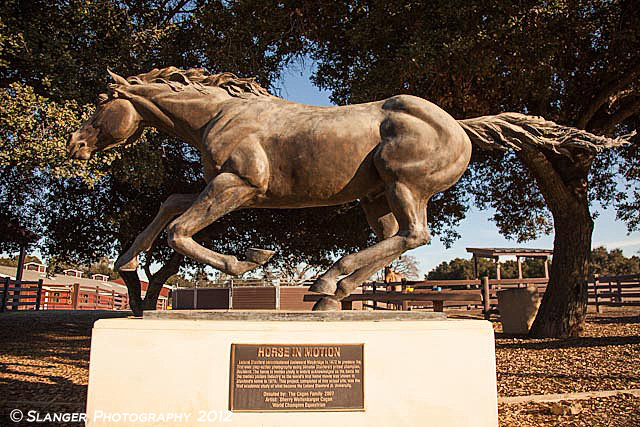

This first image is a statue of Occident, the horse used in Muybridge's film study of equine locomotion.
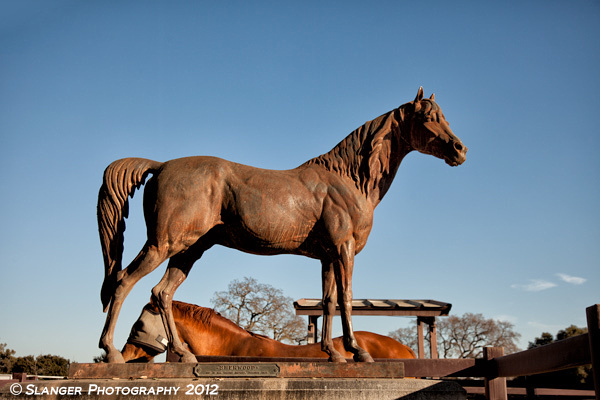

A statue of the horse, Sherwood, juxtaposed against an oblivious live horse.
While randomly photographing around the stables, an imposing bald man leaning in a doorway called out to me. "Hey, you want to see something cool?" Relieved that he was not the horse police, I agreed, and he led me behind the big Red Barn, and explained to me that he was the official farrier at the equestrian center. He invited me to photograph himself and his crew of two as they reshoed a stable of horses. I was given a demonstration on removing old shoes, and attaching the new ones. While it looks painful for the horse, I was assured that there are no nerves in the hooves, and that if done properly, the horse feels nothing. I was unable to confirm this with any horse involved. I was even allowed to hold a spliced hoof, showing the inside of a horse's foot. Still, I'm glad I slip my shoes on by myself.
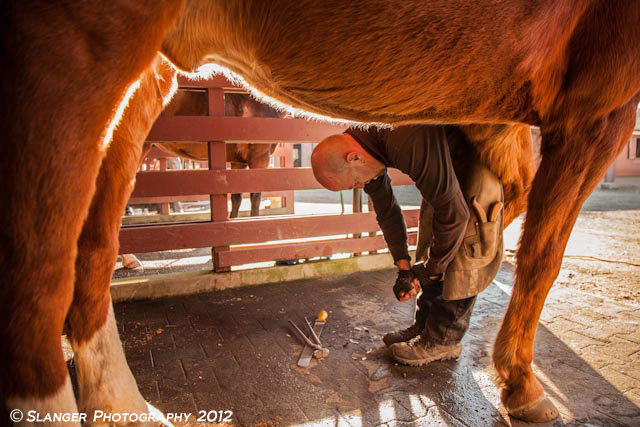

In this image, our fearless farrier was removing the nails which hold the old shoe in place. You can see the nail holes in the front right hoof.
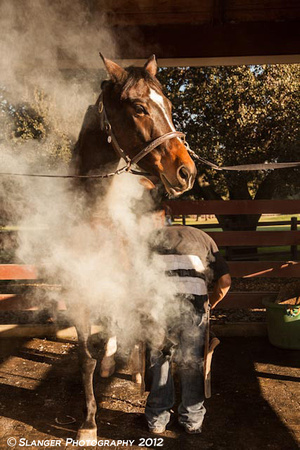

Here, the farrier is hotshoeing the horse. With a very hot shoe, he is sealing the now cleaned hoof from moisture and anything else that might cause infections. The smell is intoxicating.


After watching several horses try on shoes, it was time for my group shot, and to head out. It was a pleansant, and very unexpected adventure. Thank you to farriers across the world. You are the unsung heroes.
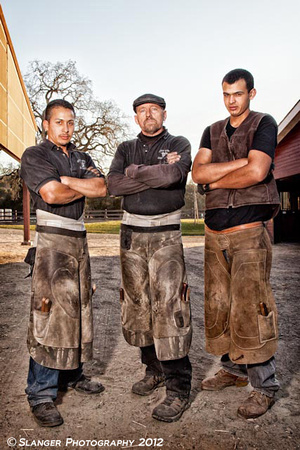

To view more of my work, please visit www.slangerphotography.com. Thank you.
From New Zealand to Australia: Part Un
My wife and recently returned from our first trip to New Zealand and Australia, and I've finally managed to organize my photogs from our adventure. I won't run through the entire itinerary, but we started in the South Island of New Zealand and made our way along the east coast of Australia. We once again used www.smartours.com, the same company we went with on our trips to Thailand and Peru. I get nothing for mentioning them, but have been consistently happy with the tours.
Following the 168-hour, time-traveling flight into Auckland, we were picked up by our tour guide, and whisked away to the Auckland Museum. There we got our first introduction into the lives of the Maori people by way of some cultural dance and brief history.
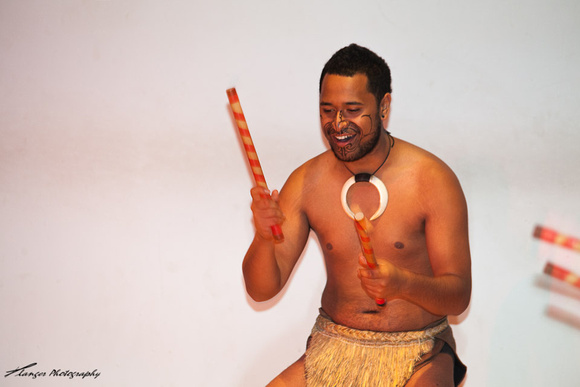

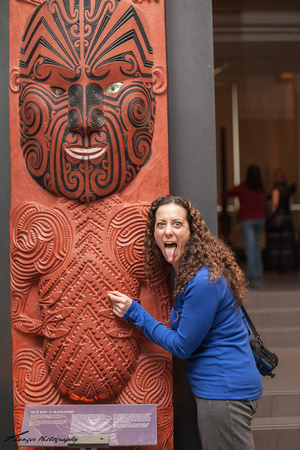

The next day we were off to Queenstown, the beautiful town on the southern edge of Lake Wakatipu. The town is surrounded by the majestic Southern Alps. If the views don't impress you, Queenstown is also the home of the Fergburger. Mmmm.....Fergburer. Where was I? Queenstown also has a beautiful park, complete with frisbee golf, tiny bridges, lawn bowling and a skateboard park.
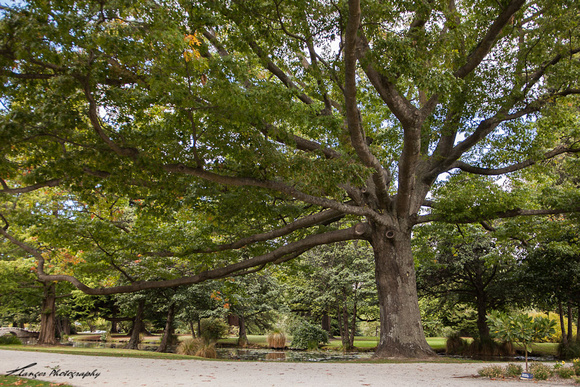

In regards to the photography, I don't intend to spend too much time on the techy terminology, but I shot the above image with a camera. As for the lens, I went relatively wide in order to cover a majority of the tree with my 17-35. Lens choice took some consideration for this trip, as I was attempting to travel as light as possible, because I tend to drag all my lenses with me on my back, and it gets grueling after about 5 minutes. My friend and photographer, Mark Fellman (see his work at..oh, yeah, he does not have a website) suggested that I take only two lenses with me. As any photographs can attest, it's not easy to leave glass behind, but I took Mark's advise and only took my 17-35 and the Tamron 70-200......and my 50mm ( I never used it). You want to cover all the needed focal lenghts, allowing yourself to photograph subjects close and at a distance. I must thank the good people at Tamron (http://www.tamron-usa.com/enews/archives/july11_slanger.asp), for they lent me the 70-200 2.8 lens, and it worked out beautifully.
One of the required sites near Queenstown is Milford Sound. Though technically a fjord, and not a sound, Milford is home to some
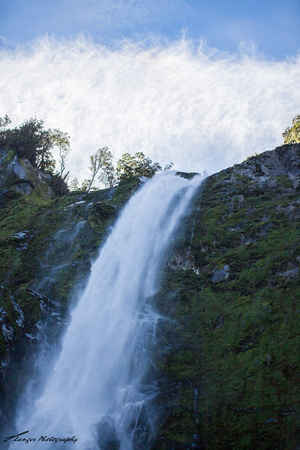

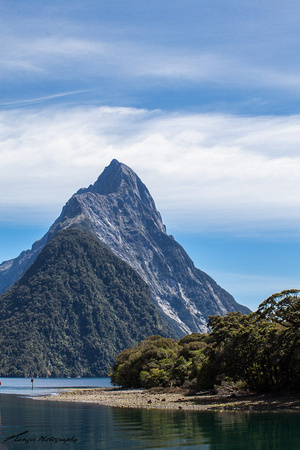

beautiful waterfalls, seals...and someone claims they saw some penguins. The next day we took a memorable ride on the TSS Earslsaw (a steamship celebrating it's centennial) to the Walter Peak Sheep Station across Wakatipu. Following my first tea (I prefer coffee) and crumpets experience, we were off to meet our first sheep of the trip, and watch a demonstration on the herding of sheep, by our host, Lindsay. If you were not aware, sheep farmers use two kinds of dogs for work. There are the dogs that bark...and there are those which use only a glare. If you have never seen a dog stare down a heard of sheep, you have not lived.
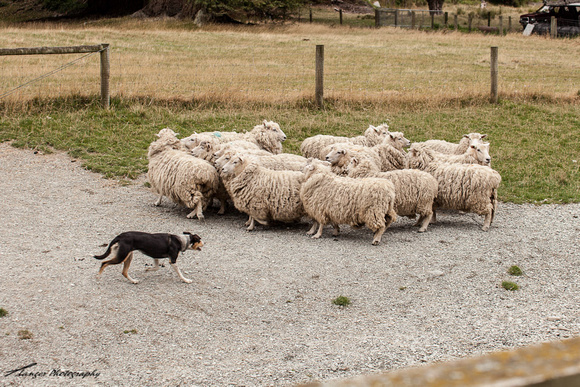

The dog nearly had me hypnotized. After the wrangling demonstration, the dog clearly took a liking to me. I later realized he was actually attacted to the extra crumpet I had heisted in my jacket. For the record, there were probably hundreds of crumpets and scones left after we departed. I don't like to waste food. Lindsay then shorn a less than anxious sheep for our amusement. Did you know that a sheep that has been sheared is said to be "shorn"? For the first few days I thought they called their sheep "Shaun." An innocent mistake. My wife is enamored by sheep, and after chasing one for several minutes, Lindsay pitied her and coerced a sheep to pose with her. Should you ever make your way to Walter Peak, make sure that Lindsay is your guide/shearer. He truly made the day an event with his dry humor.
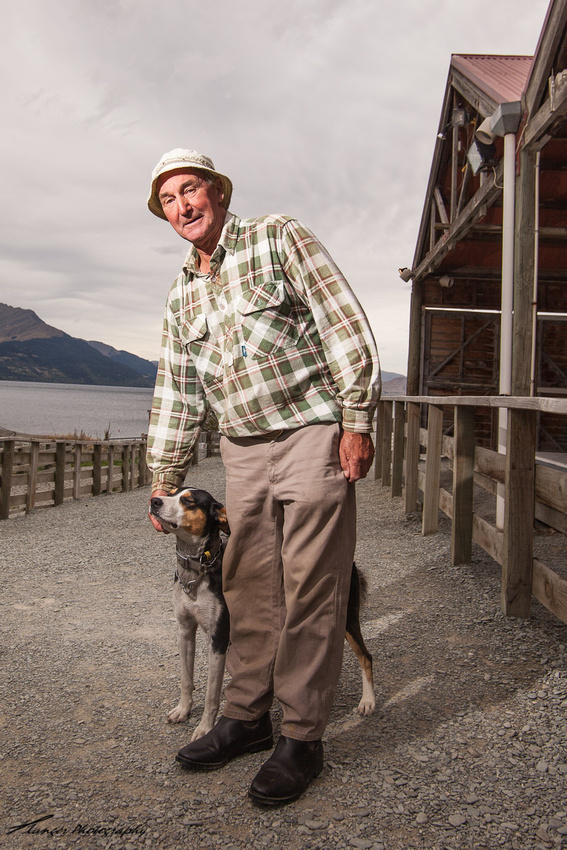

In my next installment, I will share some of my images from the Australia leg of our adventure. As always, please check out my latest work at www.slangerphotography.com.